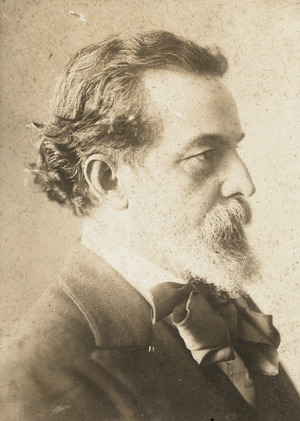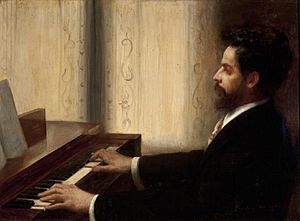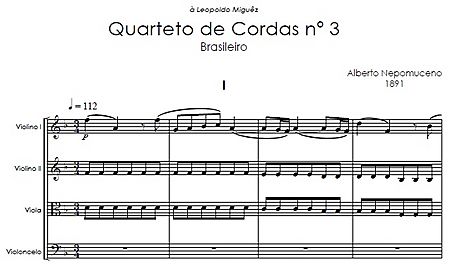Alberto Nepomuceno facts for kids
Quick facts for kids
Alberto Nepomuceno
|
|
|---|---|
 |
|
| Born | July 6, 1864 |
| Died | October 16, 1920 (aged 56) Rio de Janeiro, Federal District, Brazil
|
| Occupation | composer and conductor |
| Known for | music that reflects Brazilian culture |
|
Notable work
|
String Quartet No. 3 "Brasileiro" |
| Spouse(s) |
Walborg Bang
(m. 1893) |
| Parents |
|
Alberto Nepomuceno (July 6, 1864 – October 16, 1920) was an important Brazilian composer and conductor. He is known for creating music that showed off Brazilian culture and sounds. He also worked hard to make sure Brazilian music and the Portuguese language were respected in classical music.
Contents
Alberto Nepomuceno: A Brazilian Composer
Early Life and Musical Start
Alberto Nepomuceno was born in Fortaleza, a city in Northeastern Brazil. His parents were Vitor Augusto Nepomuceno and Maria Virginia de Oliveira Paiva. He started learning music from his father, who was a violinist and organist.
In 1872, his family moved to Recife, another city in Brazil. There, he continued to study piano and violin. As a young man, he strongly supported changes in Brazil. He wanted Brazil to become a republic, not a monarchy. He also spoke out against slavery. These efforts helped lead to the creation of the First Brazilian Republic in 1889. When he was 18, he became the director of the Clube Carlos Gomes, a music club in Recife.
Fighting for Brazilian Music
In 1885, Nepomuceno showed off some of his songs that were written in Portuguese. This was a big deal because many people thought Portuguese was not good enough for classical singing, which often used Italian. He argued with critics and newspapers about this. He believed that Brazilian classical music should use Brazilian themes and the Portuguese language. From 1896 to 1906, he worked at the Popular Concert Association. Here, he helped other Brazilian composers get their music noticed.
In 1888, Nepomuceno traveled to Europe to learn more about music. He studied in Rome and Berlin. In Berlin, he met Walborg Bang, a student from Norway, and they got married in 1893. Walborg was a friend of the famous Norwegian composer Edvard Grieg. Nepomuceno even lived in Grieg's house for a while. Grieg also believed in using local culture in music. This friendship helped Nepomuceno decide to write music that truly showed Brazilian culture. Before returning home, he visited Paris and met other famous composers like Camille Saint-Saëns.
Returning to Brazil and His Influence
When he came back to Brazil, Nepomuceno became a director and teacher at the Instituto Nacional de Música (National Institute of Music) in Rio de Janeiro. He kept pushing for the use of Portuguese in Brazilian classical music. He had a big impact on many young Brazilian composers. Some of his students, like Heitor Villa-Lobos, became very famous later on.
Later, the famous conductor Gustav Mahler asked Nepomuceno to conduct at the Vienna Opera House, but Nepomuceno became ill and could not go. In 1910, he went back to Europe for concerts in different cities. During this trip, he became friends with Claude Debussy, another important composer. Back in Brazil, he continued to be a leading musical figure until he passed away at age 56. He always supported using Portuguese in opera and songs.
Important Musical Works
Nepomuceno wrote many important pieces. One of his most famous is his String Quartet No. 3, called "Brasileiro" (Brazilian). He wrote it in Berlin in 1890. This piece is special because it was one of the first to mix Brazilian folk melodies with European classical music styles. The "Brasileiro" String Quartet was not published until 2005 and was rarely performed before then.
Other notable works include his operas Abul (1905), Artemis (1898), and Electra (1894). He also wrote orchestral pieces, a symphony, and a serenata.
The Opera "O Guaratuja"
Nepomuceno's opera O Guaratuja is a comedy. He started writing it in 1904, but he only finished the beginning part (called the Preludio) and the first act. The Preludio was first performed in 1904 at the Theatro Municipal in Rio de Janeiro, with Nepomuceno himself conducting.
The music for O Guaratuja mixes older classical styles with popular Brazilian rhythms from the late 1800s. This gives the opera a unique Brazilian feel. The story for O Guaratuja comes from a novel by José de Alencar, a famous Brazilian writer. The opera is set in 1659 in the old colonial city of São Sebastião do Rio de Janeiro, which is now modern-day Rio de Janeiro. "O Guaratuja" is the nickname of the main character, who is an artist who likes to draw graffiti on walls.
See also
 In Spanish: Alberto Nepomuceno para niños
In Spanish: Alberto Nepomuceno para niños



